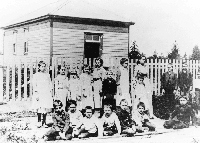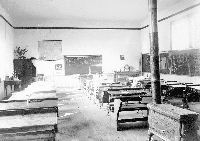Richmond Schools
Richmond Schools - What's in a Name?
125 Years of Change and Expansion
 | Group of students shown outside Sea Island School, circa 1918. City of Richmond Archives Photograph 1978 1 19. Click to enlarge image. |
Since Richmond's incorporation in 1879, the community's development from a handful of farmers and fishermen in the late 1800s can be traced to today's thriving diversified city of 174,000 inhabitants. Two World Wars, a Depression, a Baby Boom, and world geo-politics in general have changed the face of Richmond profoundly from a rural community based on the primary industries of farming and fishing, to a mixed economy emphasizing high tech industries in the most multi-cultural community in all of Canada today.
 |
| Interior of Steveston School, showing desks, |
As the community has expanded, so too has the Richmond School System: from home schooling and the one-room schoolhouses of the late 19th century, to the plethora of schools in existence today, including 39 elementary and 11 secondary schools in the public school system, and a handful of private schools.
This exhibit, "Richmond Schools - What's in a Name?," traces the expansion of the Richmond school system over the past 125 years, emphasizing how and why each school was given its name, and therefore, a part of its identity. The exhibit is organized into sections corresponding to periods of growth and development within the Richmond school system and in the community itself.
Explore the links below - or use the Richmond Schools Index - to learn more about each of Richmond's schools and how they got their names. You should find that by learning about the naming of Richmond's public schools, you will discover an abbreviated history of the community itself. (For current school information please visit the Richmond School District website.)

